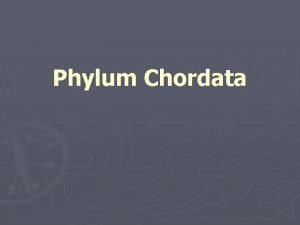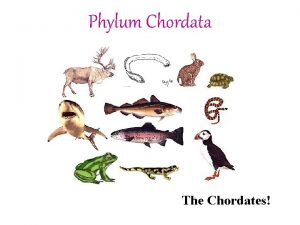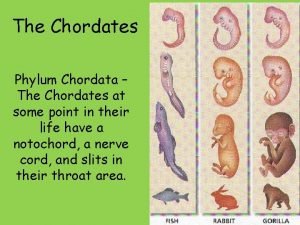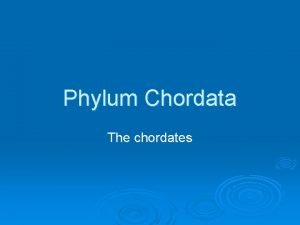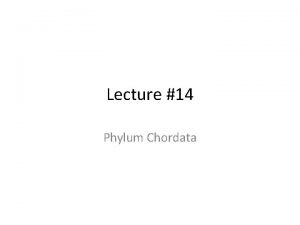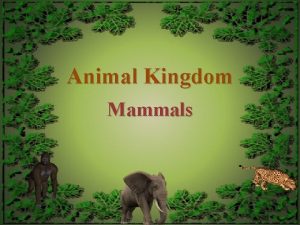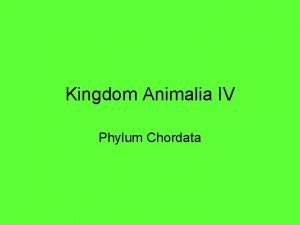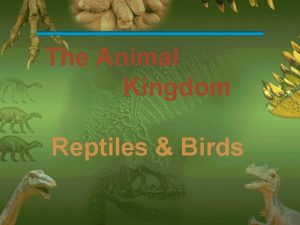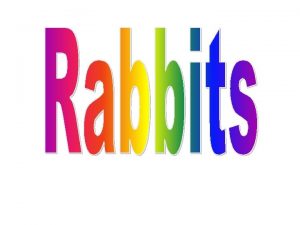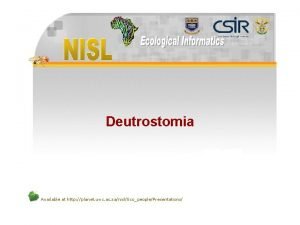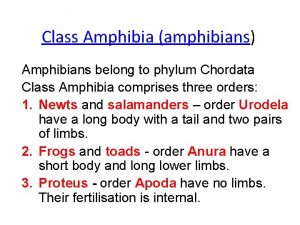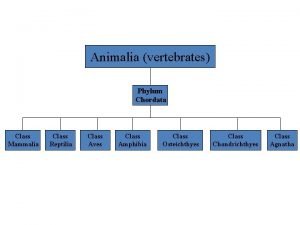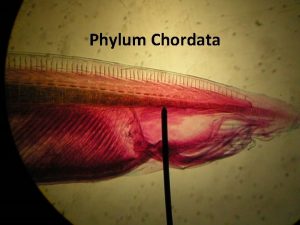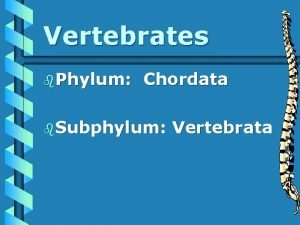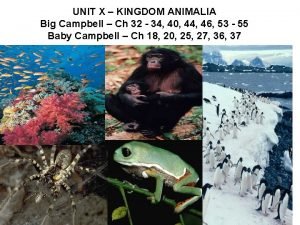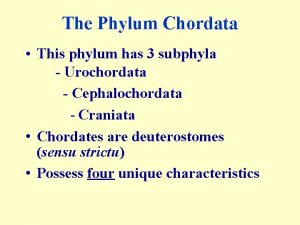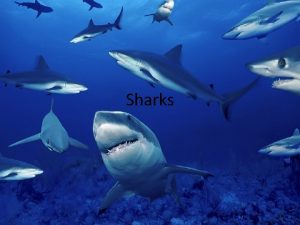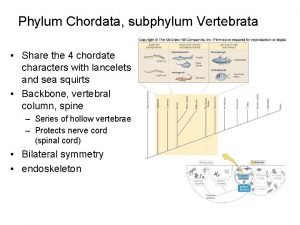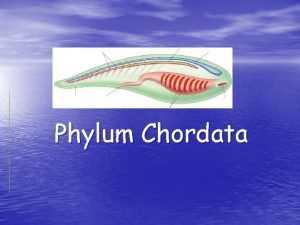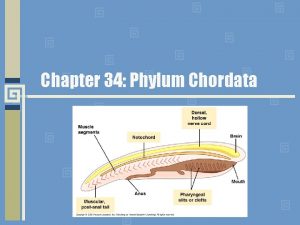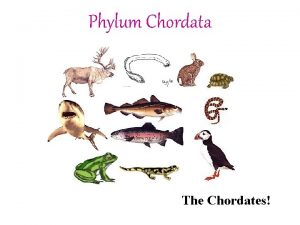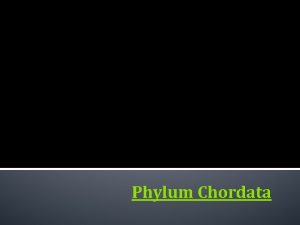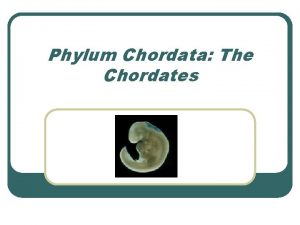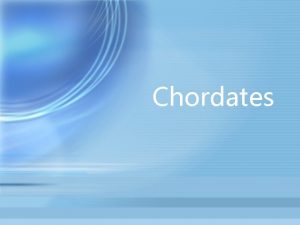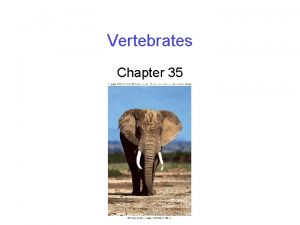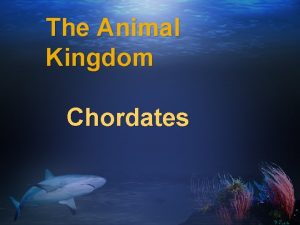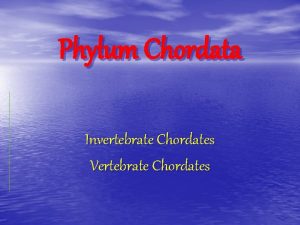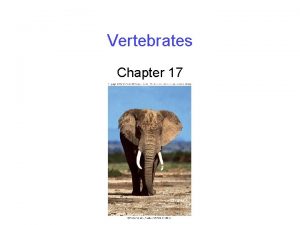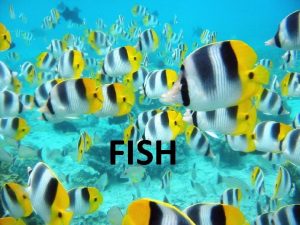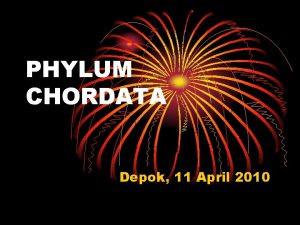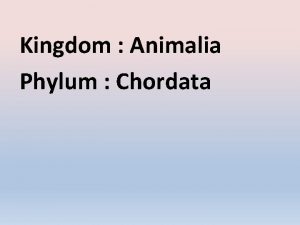Phylum Chordata StringCord Common Characteristics All chordates have


















- Slides: 18

Phylum Chordata “String/Cord”

Common Characteristics • All chordates have the following characteristics at some point in their life – In many vertebrates, certain features may only be present as an embryo

Common Characteristics • Pharyngeal slits – series of openings that connect the inside of the throat to the outside of the "neck". Often, but not always, used as gills • Dorsal nerve cord - bundle of nerve fibers which runs down the "back". Connects the brain with body regions/organs

Common Characteristics • notochord - cartilaginous rod running underneath, and supporting, the nerve cord. This is the “backbone” of vertebrates • post-anal tail - an extension of the body past the anal opening

3 major sub-phyla • Subphylum: Cephalochordata (head cord) – AKA Lancelets or “Amphioxus” – First animals with a spinal cord – Exclusively marine, roughly fish shaped – Can swim, but usually buried in sand with anterior end exposed – Filter feeders • Oral hood lined with cilia creates water flow • Water exits through atriopore

Lancelets or “Amphioxus”

3 major sub-phyla • Subphylum: Urochordata (tail cord) – Class: Ascidiacae (little bag) – sea squirts or Tunicates • Adults are sessile, with sac like protective tunic • Larva are free swimming with chordate feature • plankton feeders (filter feeders) – Class: Larvacea (ghost like) • Free swimming throughout life • plankton feeders (filter feeders) • as adults, they resemble larvae ascidian

Ascidiacae (Tunicates)

Larvacea (ghost like)

3 major sub-phyla – Urochordata cont… – Class – Thaliacea (luxuriance ) Sea Salps • barrel shaped • plankton feeders (filter feeders) • bioluminescent = phosphorous

Subphylum Vertebrata “joint of the spine” • Largest group of chordates (58, 000 species) • Vertebrates make up 5% of all animal species • Range in size from 0. 3” species of carp to 110’ Blue Whale. • Bilateral symmetry • Includes 7 classes

Class Agnatha – “no jaws” • Lamprey eel (sometimes parasitic to fish), Hagfish • Jawless, circular mouth, usually with retractable teeth • Notochord is a flexible cartilage rod • Lack paired appendages

Class Chondrichthyes “cartilage fish” • Sharks, rays, skates • Approx. 750 species • Skeleton is cartilage, not bone • No ribs • Paired appendages

Class Osteichthyes “bony fish” • All fish that have bony skeletons • Largest class of vertebrates (29, 000 species) • All possess gills for aquatic respiration • Largest species is Ocean Sunfish (11’, 5, 000 lb) • Dwarf Pigmy Goby is smallest (0. 59”)

Class Amphibia “dual life” • Frogs, toads, salamanders, caecilians • Approx. 6, 500 species • Adapted to life in water or on land • Most are 4 limbed • Gas exchange through lungs, gills, & skin

Class Reptilia “to creep” • Snakes, turtles, lizards, alligators • Over 8, 000 species inhabit every continent except Antarctica • All reptiles have scales • All reptiles breathe through lungs

Class Aves “flight” • 10, 000 living species of birds – Most species of all tetrapod vertebrates • Inhabit every ecosystem on Earth • All birds have feathers and wings • Sternum is keeled for attachment of flight muscles – the “wish-bone”

Class Mammalia “breast” • • Over 5, 000 species Mammary glands produce milk Hair or fur for protection Almost all give birth to live young, nourished by placenta • Able to maintain body temp. internally • Largest brains of all vertebrates
 Chordata distinguishing characteristics
Chordata distinguishing characteristics Chordata images
Chordata images Characteristics of all chordates
Characteristics of all chordates Peces cartilaginosos
Peces cartilaginosos Gill arches
Gill arches Playtpuses
Playtpuses Kingdom animalia phylum chordata
Kingdom animalia phylum chordata Animal kingdom phylum chordata
Animal kingdom phylum chordata Entertoxemia
Entertoxemia Phylum chordata
Phylum chordata Phylum chordata class amphibia
Phylum chordata class amphibia Mnemonic for kingdom phylum
Mnemonic for kingdom phylum Phylum chordata class reptilia
Phylum chordata class reptilia Chordata taxonomy
Chordata taxonomy Characteristics of subphylum vertebrata
Characteristics of subphylum vertebrata Cotoderm
Cotoderm Tunicate
Tunicate Phylum of sharks
Phylum of sharks Digestive system of chordata
Digestive system of chordata
